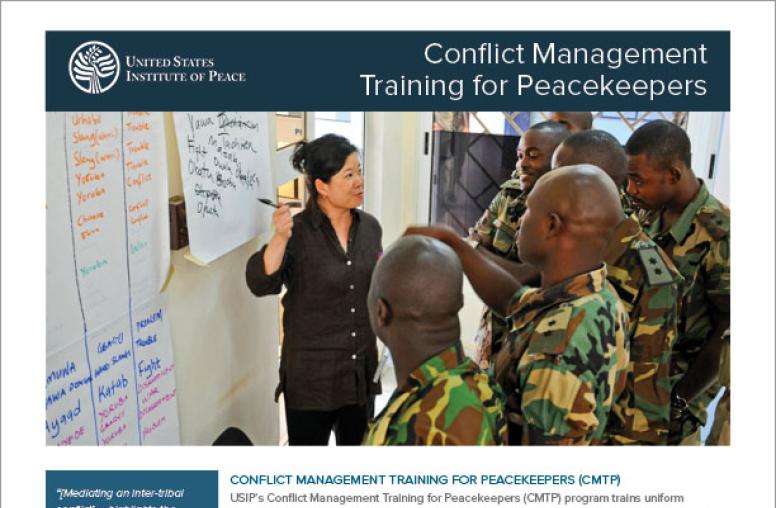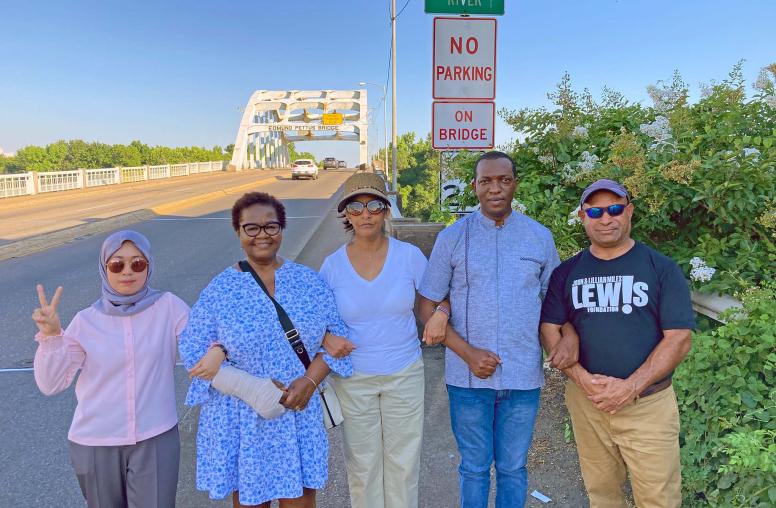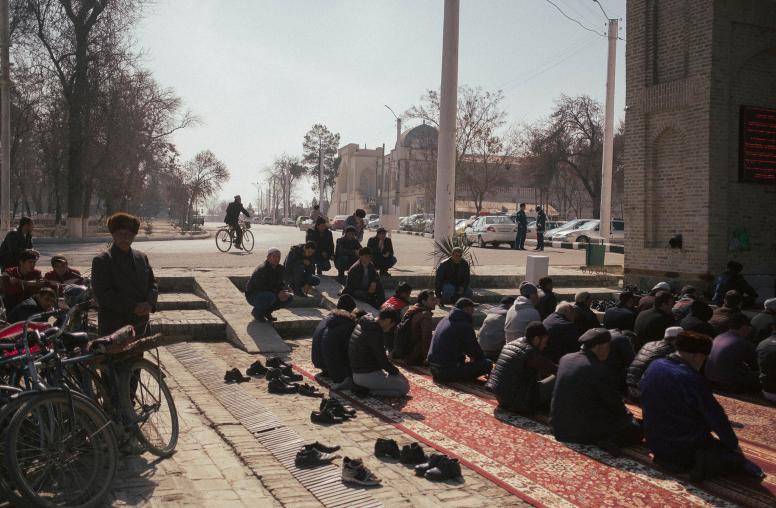Training for Peace and Humanitarian Relief Operations: Advancing Best Practices
Peaceworks No. 43
While the four communities in peace operations--governmental and non- governmental organizations (NGOs), the military, and international civilian police--frequently find themselves sharing the same field of operation, their approaches to and structures for training for that interaction and the articulation of training needs are quite different.

Executive Summary
While the four communities in peace operations--governmental and non- governmental organizations (NGOs), the military, and international civilian police--frequently find themselves sharing the same field of operation, their approaches to and structures for training for that interaction and the articulation of training needs are quite different. In the past, this has led to confusion, suspicion, and a diminished capacity for cooperative action among the communities. All sides recognize the benefits of and need for better coordination and increased operating efficiencies, but making the kinds of changes that are required will not be easy.
In an ideal world, all the participants in any given humanitarian response effort would share a common understanding of one another's capabilities and limitations, as well as their roles and missions. Overlapping efforts would be kept to a minimum while cooperation in the pursuit of progress and solutions would be instinctive. In the real world, however, mission analysis is often ad hoc; training is spotty and tends to focus on individual agency goals, and coordination with other organizations is worked out on the fly. These were the main conclusions of a two-day symposium on best practices in conflict management training, sponsored by the U. S. Institute of Peace, June 25-26, 2001.
Another key difficulty civilian elements of the international community face is the trap of attempting to work "outside the box." The governmental and NGO communities greatly value flexibility and creativity, often leading to early calls for innovative problem solving. Unfortunately, this premium on creativity also reflects the communities' tendency toward "ad hocism" and the problem of having many officials, volunteers, and experts jump from crisis to crisis without ever learning enough about the details "inside" their respective boxes.
The communities come at the problems from different directions, sharing good intentions and a general recognition that somehow their coordination needs to be better. The difficulty lies in the details of responsibility sharing and the general lack of common training and preparation. Although the military and the international civilian police operate in more structured and content-based training environments, the U. S. government and NGOs come to the task from a process of experience-based learning that is less formal and better suited to their personnel. The key to better collaboration in the future is not training uniformity, as some espouse and others fear, but rather developing a method for regularly blending these disparate groups into training environments that allow them to learn with and from one another. Yet to do so, there must be an acknowledgment of some existing constraints.
The nongovernmental community faces some difficult challenges with regard to formalized training. Foremost among these is its members' need to raise funds to carry out their missions. This is a constant need, which sometimes shapes the scope and timing of their interventions while indirectly affecting their ability to conduct internal training. Training requires money, and training costs increase organizational overhead. In an era when donors and the media are increasingly focused on the bottom line and tend to rate humanitarian organizations by what percentage of donations goes to the ultimate beneficiaries, the need to explain and justify administrative costs is a pressing concern. The challenge for the near future is to promote an attitude within the NGO and the donor communities that the right kind of training increases organizational capacity for success in areas donors and major actors, such as the military, value.
The situation is similar within the myriad organizations of the U. S. government that routinely or occasionally become involved in "complex emergencies"--humanitarian relief operations that become more hazardous when warlords or competing factions try to capitalize on the chaos of a natural or man-made disaster and on the supplies the international community brings to the host country in an intervention. These organizations share with the NGO community a preference for experience-based training, and, lacking a systematic training curriculum on the management of complex emergencies, they tend to fall back on their personal skills and general knowledge of statecraft, development assistance, or interagency processes when such emergencies arise. It has been suggested that the two greatest impediments to collaborative training progress within this community are the lack of a single, full-time coordinating structure and the lack of a centralized training facility wherein members of the various organizations could come together to learn from one another and share a common training experience.
The idea of creating an interagency coordinating structure receives only lukewarm interest from relevant governmental agencies, which are reluctant to create a separate entity that would direct field operations from Washington, D. C. However, if the focus of that entity were confined to coordination, facilitation, and support, while preserving the agencies' autonomy of action in the field of operations, such an entity's value would be undeniable, particularly in the initial phases of an operation. There is a similar reluctance to creating a standing, deployable cadre of trained individuals to facilitate operations in the field, though this model has proven its worth in joint military operations. For existing agencies, the perceived need is not for new or collateral organizations but for the better utilization of existing organizations and better coordination among them.
One segment of the international community engaged in peace operations that is steadily gaining acknowledgment and moving toward an improved training posture is international civilian police (CivPol). With the increased recognition that public security (that is, the maintenance of law and order in the broad sweep of social institutions) is a critical element in post-conflict reconstruction, the scope of CivPol engagement is broadening, and organizations--particularly the United Nations--are paying more attention to harmonizing international CivPol training. CivPol contingents typically include volunteers and seconded law enforcement officers from more than seventy countries who come together in a variety of complex operations, so it is easy to see the need for common policing standards and practices.
CivPol training falls into two basic categories: training received at home before deployment and training received in the recipient country, including induction and specialized training. Predeployment training is the responsibility of the countries donating their police officers to the international mix. Countries approach police operations differently, and their forces have different standards, levels of skill, and experience; they also have different views of the world that are based on their specific political cultures and legal traditions. Induction and specialized training in the host country are largely the responsibility of those forces already deployed, though the UN has acknowledged that it has a role to play in helping to standardize this training. Such training should focus on local police practices, the administrative support structure, working with the local population and local police, expanding contacts for information on the local situation, reporting and communication procedures, coordination with other agencies and organizations, and team- building practices. In short, international civilian police are now being asked to do far more than simple monitoring. They are afforded great responsibility in unstructured, dangerous, and highly politicized environments that are often characterized by conflicting guidance and limited or nonexistent judicial systems. The expressed desire of many former CivPol officers and others working in peacekeeping missions is that international civilian police should have a standard training package; common uniforms, rank structure, and equipment; uniform disciplinary guidelines; a single chain of command; and more accountability.
The military is the only community that is imbued with a training culture and is given the resources to conduct significant, if not always adequate, training. Its primary mission and focus are combat training to fight and win the nation's wars; proficiency training for this primary mission leaves little room for collateral training in other areas. For example, the U. S. Army's training system is built on a process of mission analysis, task identification and assignment, evaluation of current proficiency, and hands-on training designed to raise proficiency to required levels. Of all the groups involved in peace operations, it is the only one that has a systematized approach to identifying the skills needed to accomplish particular tasks. It highly values experience in the form of lessons learned, but it is largely devoted to content-based instruction that provides uniform skill training throughout the force.
Training for specific skills and tasks does not appear to have diminished the military's capacity for innovation or its agility in responding to changing and uncertain circumstances. Rather, it broadens the core competencies of its members so that necessary adjustments new challenges pose can be made without much disruption. It also enables the military to reach out to other peace operation actors more easily and to see the synergy that can be achieved by active coordination. The natural reluctance of governmental and nongovernmental agencies to be seen as working with the military in complex emergencies has diminished in recent years, and NGOs in particular are finding that a collaboration can benefit all parties.
To be sure, the two days of the symposium elicited some "best practices" for the conduct of training in peace operations. Yet, as was the case with the first symposium the U. S. Institute of Peace sponsored on "best practices," more often the presentations and discussions defined areas where improvement was needed and possible.* The presenters offered a great deal of information and some surprising recommendations, and, as always, discussion from the floor was spirited and insightful.
The discussions clearly identified individual and collective areas for future improvement. Collectively, the symposium's attendees suggested that regular participants in humanitarian and crisis intervention would benefit from increased peacetime interaction and communication, as well as from an ongoing synergistic process of building a common understanding of mutual strengths, weaknesses, and responsibilities in the field. In recent years, there has been some movement toward common training in joint exercises, seminars, and planning forums, but this effort has been largely hit-and-miss; what progress there has been must be institutionalized and the experience broadened to include more potential players in complex humanitarian reliefinterventions.
Equally important, the individual groups represented at the symposium need to further their efforts toward understanding what their particular roles and missions might include in a humanitarian crisis and toward developing standardized task training to present to those most likely to need the information and practice. As might be expected, the military has taken the lead in this area, using a standard mission-analysis methodology and developing a task-conditions-standards training package for each mission requirement. Recognizing the need for uniformity oftraining for its international police candidates, the United Nations is developing a standardized training curriculum and materials that it hopes to share with donor countries as a means ofassembling a force that has experienced some common core training.
Although both the U. S. government agency and NGO communities recognize the need for common and more efficient training, the lack ofcommitment in terms of organizational culture, as well as the lack oftime and resources, limits their efforts. Hence, if the problem is the lack ofbetter integrative processes, one suggested solution would be to have a department or agency of the U. S. government take the lead in developing core training requirements and assign responsibilities to various agencies and other participants that could then be trained at a common-use facility devoted to international training and response to complex emergencies. Doing this, however, would require significant resources, as well as a consensus among the agencies and the governments that support them.
About the Author
Robert M. Schoenhaus is a former program officer in the Training Program at the United States Institute of Peace and acted as principal rapporteur for the symposium.
Notes
* For a report on the first symposium, held June 27–28, 2000, see Robert M. Schoenhaus, Conflict Management Training: Advancing Best Practices. Peaceworks no. 36 (Washington, D.C.: United States Institute of Peace, January 2001).



